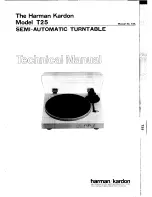
10
F I T T H E M O T O R
Fit the motor to the motor plate using the 3 small machine screws supplied. These screws should be “just” tight to keep
motor noise to a minimum. The motor fits on the underside of the motor plate – see “diagram of sub-chassis assembly”.
The motor plate is adjustable to enable optimum belt tension to be achieved – details of this are given in the motor
installation notes but generally the optimum position is such that marker bolt in the “slot” is located at the mid point of
the slot.
I N S T A L L S U B - C H A S S I S & F I T S P R I N G S
Offer up the sub-chassis assembly into the plinth and fit the springs as shown in the “ diagram of support rods and
spring arrangement”. Each particular spring is of a different compliance and should be in the positions shown in the
“diagram showing spring positions
D I A G R A M S H O W I N G S P R I N G P O S I T I O N S
MEDIUM
SPRING
POSITION
THICK
SPRING
POSITION
THIN
SPRING
POSITION
C O N N E C T T H E M O T O R W I R E S
Solder the red wire from the dc regulator board to the positive terminal on the bottom of the motor (this has a
faint in sign alongside it). The black wire attaches to the other motor terminal. If you do not have a
soldering iron then you can simply wind the wires round the terminal holes and glue them in position with a blob
of evostick or similar – ensure that the wires to not make electrical contact with the motor body.
Lead the bullet connector wires out through the hole in the rear of the plinth and connect them to the power
supply leads using the bullet connectors. These connectors may not look esoteric but they are made of copper as
opposed to the brass commonly used in most connectors.
Screw one of the cable clips onto the inner side wall of the left hand side of the plinth (see “top view of wiring
layout and connections”) such that it holds the input and motor wires (brown, blue, red & black) away from the
sub-chassis and any danger of restricting it’s movement. For full details on the motor and power supply set up
you need to read the separate sheets provided.
I N S T A L L T H E A R M
It is necessary to fit the tonearm to the deck, before final “levelling” of the sub-chassis so that the weight distribution is
correct. At this stage the arm simply needs to be in position – it does not need to be adjusted for height or have the
cartridge fitted etc.






































